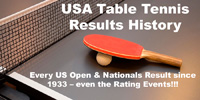Don’t be that guy who spends years smacking shots but also missing over and over, putting balls all over the table, or off or into the net, and never putting it together consistently. If you are swinging wildly in practice, even if you are making most shots, you are just practicing being erratic. To hone your shots, you need to be able to do the same shot over and Over and OVER, and against all sorts of incoming balls. If you are even a bit erratic in practice, in the uncertainty and pressure of a match that means missing a LOT. (In practice, you often get the same balls over and over. Not so in a match.) That means practicing at a speed where you are consistent, and then building it up. Eventually, with practice and good form, you’ll be able to essentially relax into any shot, even power shots, and make them with ease.
Watch the top players and notice how little they strain on each shot. That’s good form. Try to do the same thing. Just remember, if you are doing a drill and are hitting shots all over the place, you are practicing being a poor player. If you are inconsistent with your shots, then you are practicing inconsistency in your shots. Be that guy who IS consistent, even if it means at a slower pace, and watch your game improve. Added bonus – if you are a consistent player, stronger players will want to practice with you. Who wants to practice with someone who smacks balls all over the place?





